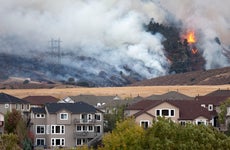Does your homeowners insurance go up after a claim?

The Bankrate promise
At Bankrate, we strive to help you make smarter financial decisions. To help readers understand how insurance affects their finances, we have licensed insurance professionals on staff who have spent a combined 47 years in the auto, home and life insurance industries. While we adhere to strict , this post may contain references to products from our partners. Here's an explanation of . Our content is backed by Coverage.com, LLC, a licensed entity (NPN: 19966249). For more information, please see our .
Homeowners insurance is important for ensuring both your financial security and to help maintain the roof over your head in the event of the unexpected. If your home suffers damage from anything from a break in to a natural disaster, homeowners insurance can pay out for repairs and replacements needed. However, homeowners may question, “Does home insurance go up after a claim?” While your home insurance will be affected following a claim, understanding what can happen to your insurance premium can help you decide whether it’s worth it to file one.
How much does your homeowners insurance increase after a claim?
Filing a home insurance claim may cause your premium to increase temporarily. The amount your premium will increase after a claim depends on a variety of factors, including:
- Type of claim
- Extent of the damage
- Where you live
- Your personal claims history
It is also possible for your home insurance rate to increase based on the frequency of claims in your area. For example, after a major hurricane that causes extensive damage in your community, your insurance rate might increase more substantially than it would if you filed a single property damage claim.
With a clean claims history, the average annual cost of homeowners insurance with $300,000 in dwelling coverage is $2,151. The table below highlights several types of claims, the average payout and average annual rate after the claim.
| Type of claim | Average dollar amount of claim paid out* | Average annual rate after a claim |
|---|---|---|
| Wind | $12,913 | $2,254 |
| Liability | $31,663 | $2,286 |
| Theft | $4,646 | $2,301 |
| Fire | $83,519 | $2,299 |
*Based on the Insurance Information Institute’s (Triple-I) estimates of average home claim payouts. Average rates based on a claim filed on a home insurance policy with $300,000 in dwelling coverage.
Why do insurance premiums go up after filing a claim?
Homeowners insurance rates often increase after a claim because it leads your insurance company to believe that you are more likely to file another claim in the future. This is especially true for claims related to water damage, dog bites and theft. To compensate for another potential claim payout, the property insurer proactively raises your premium.
As mentioned, whether or not your insurance premium increases after a claim is situational. Certain types of claims affect insurance rates more than others. You should expect your rate to go up after a claim if you fall into any of the following categories:
- You live in an area with severe weather
- Your home is located in a high-crime area
- You have filed liability claims in the past
- You own a home with a history of claims
- You file more than one claim over several years
Generally speaking, your insurance premium is more likely to increase if you file a liability claim rather than a property damage claim. With a liability claim, there is a chance that you could face a lawsuit. Legal fees and court settlements can be very expensive, which means there is added risk for you and your insurance company.
How long does a claim affect home insurance rates?
If your homeowners insurance rate increases after a claim, know that it is not a permanent rate hike. Most claims stay on your record for roughly five years. However, this depends on the insurance company. A claim could remain on your record for as little as three years or as many as seven years. After that time, your premium should go back down, although it may not return to the original rate.
Learn more: Affordable home insurance companies
Are there times when companies are not allowed to increase rates after a claim?
There are many situations when property insurance companies can raise your rate after a claim. But there are also certain situations when an insurance company is not allowed to increase your rate. Because insurers are regulated at the state level, consumer protection laws vary based on your location.
Some of the situations that prohibit insurance companies from raising premiums include:
- When a homeowner inquires about filing a claim, but does not submit one.
- When a homeowner files a claim that does not result in a payout (denied claim).
- When a homeowner files a single claim.
- When a homeowner files a claim due to natural disaster damage.
As a homeowner, it is important to understand the consumer protection laws in your state. You can contact your state’s department of insurance to learn more about the restrictions where you live. You can also contact your insurance company to find out what situations are exempt from rate changes.
Frequently asked questions
-
-
The best homeowners insurance company is different for every homeowner. It depends on where you live, what type of policy you want, how much coverage you need and your budget. Before purchasing a policy, take the time to shop around and compare insurers. Get a few quotes from several property carriers to see which one can offer the best price. For a true comparison on price, gather quotes with the same coverage limits and deductible from each carrier.
-
To give you an idea of the average cost of homeowners insurance, U.S. homeowners pay an average of $2,151 for $300,000 in dwelling coverage per year. Keep in mind that your exact cost might be higher or lower depending on your location, your home’s size or age and your claim history. You might pay more if you’ve purchased endorsements, but you may also receive discounts depending on your insurance provider.
-
Filing a claim is usually a reliable way to make your insurance premium go up. Before you immediately file a claim after facing loss to your home, determine if it would be cheaper to pay for the repair work or replacement items out of pocket. If the cost is extensive or more than your deductible, you may want to file a claim.
In addition to being intentional when deciding whether to file claims, you can also improve your credit, update your home’s security or safety features, stay on top of home maintenance and bundle policies with your insurance provider to aid in preventing your rates from increasing. These are all factors home insurers may consider when setting rates or offering discounts on your policy. While these might help you score an affordable rate, it also helps to shop around at renewal time. You might find that you can get the same coverage levels at a more affordable price through a different insurer.
-
Whether your homeowners insurance premium goes up after you file a claim depends on a few factors. One of those factors includes the type of claim you file. Generally speaking, liability claims, water damage and theft will impact your premium more than a property damage claim. Furthermore, a new claim may have a more significant impact on your premium if you live in an area that experiences extreme weather, in a neighborhood with a high crime rate, or have filed claims in the past.
-
Methodology
Bankrate utilizes Quadrant Information Services to analyze April 2024 rates for all ZIP codes and carriers in all 50 states and Washington, D.C. Quoted rates are based on married male and female homeowners with a clean claim history, good credit and the following coverage limits:
- Coverage A, Dwelling: $250,000
- Coverage B, Other Structures: $25,000
- Coverage C, Personal Property: $125,000
- Coverage D, Loss of Use: $50,000
- Coverage E, Liability: $300,000
- Coverage F, Medical Payments: $1,000
The homeowners also have a $1,000 deductible, a $500 hail deductible and a 2 percent hurricane deductible (or the next closest deductible amounts that are available) where separate deductibles apply.
These are sample rates and should be used for comparative purposes only. Your quotes will differ.
Claims: Rates were calculated based on the following insurance claims assigned to our homeowners: “fire ($80,000 in losses), liability ($31,000 in losses), theft ($5,000 in losses) and wind ($12,000 in losses).”
Related Articles



